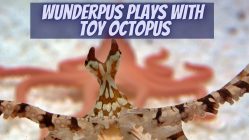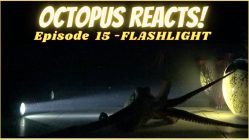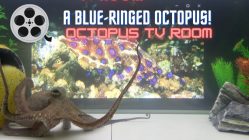It is understood that octopuses are intelligent creatures. It can be accurately stated that they are the smartest and most cognitively advanced of invertebrates.
Their level of astuteness, problem-solving — and even self-expression — places them not only at the top of all mollusks but also among the top tier of animal intelligence in general. In some cases, even above many mammals.
Animal intelligence goes hand in hand with the evolutionary advancement and development of the brain and nervous system of the species involved. This means that the better a species has evolved to mentally meet the challenges of its habitat while also remaining versatile and adaptive to future changes, the better chance it has to survive. A side benefit to this is that it also sharpens the acuity of many of its biological systems. Chief among these, vision.
The Significance of Vision

Obviously, vision is important. Being able to see offers a creature an advantage in finding food, seeking shelter, and avoiding predators. While there are successful animal species which are blind, they have to compensate for their lack of vision through enhancements of one or more of their other perceptive senses. While functional and effective, that solution is still limiting.
Earthworms are very successful as a species even though they are blind. Their population numbers are a testament to this. However, focusing on an individual earthworm quickly reveals that their success is due to their ability to propagate themselves, not to the performance or ability of an individual worm. If you were to spend any amount of time observing an earthworm, it will never impress you with its intelligence.
In animals possessing the ability to see, the more developed that ability is, the more it contributes to further stimulating additional advances in their brain development. It can lead to more complex coordination with other senses, which in turn, further advance the performance of the brain.
You see, seeing is much more than just seeing. It’s about being.
In the case of octopuses, with only a cursory look at their eyes, you can sense the vibe of the individual octopus. Much like looking into the eyes of a person, a dog or a cat, the eyes of an octopus exude a sense of being. Some would describe it as a palpable form of self-consciousness.
This is why people who handle and care for octopuses in aquariums are quick to describe the individual octopuses that they care for in terms of their personality. They begin to discern individual expressions from the octopus merely by how they are looking at them. No matter how close you are to a goldfish, you’ll never get that sense of bonding from how they look at you.
How Well Developed Is Octopus Vision?

When you look at any of the 300 or so octopus species, you will notice that three physical characteristics are held in common by all of them. They have eight arms, one large head, and two large eyes.
A closer examination of the eye of an octopus reveals that it is a very complex structure. An even deeper study of how the eye is integrated into the neurology of the octopus unveils how much more impressive octopus vision is.
Succinctly stated, octopus vision is very advanced.
The Octopus Eye Structure
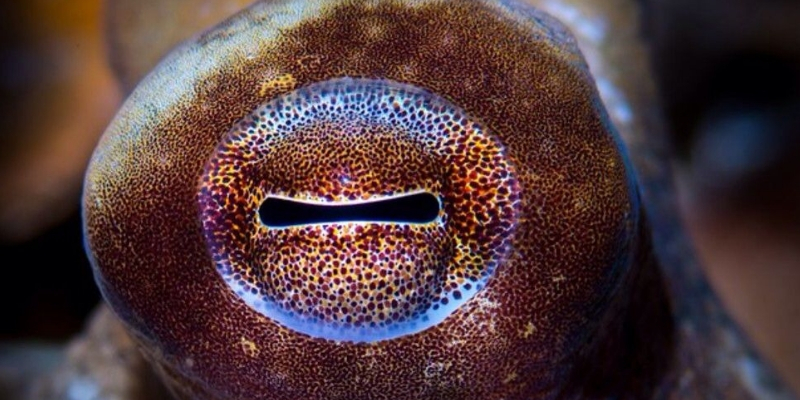
The eye of an octopus is categorized as being of the “camera variety.” The human eye is categorized the same way.
The primary structures of an octopus’ eye are the iris, lens, vitreous gel (the mass of the eyeball), pigment cells, photoreceptors, retina, and the optic nerve.
If those anatomical terms sound familiar to you it is because our own eyes have the same structures. In fact, octopus eyes and human eyes share many qualities and attributes. Even so, some scientists believe that the octopus eye and the human eye are examples of convergent evolution. In other words, we both developed our own eye structures independently. It was not a trait which we both picked up from our last common ancestor some 750 million years ago.
It is hypothesized that our last common ancestor did not possess eyes at all. At most, it may have had what are known as “eye spots.” These were areas on its head with primitive photoreceptive cells that responded to the presence of light. This would mean that both the complexities of the human and octopus eye developed independently much later.
How Does an Octopus Eye Work?
Even though convergent evolution made the human and octopus eye quite similar, there are key differences. These differences affect the way that octopuses see compared to the way that we see.
Moveable Lens
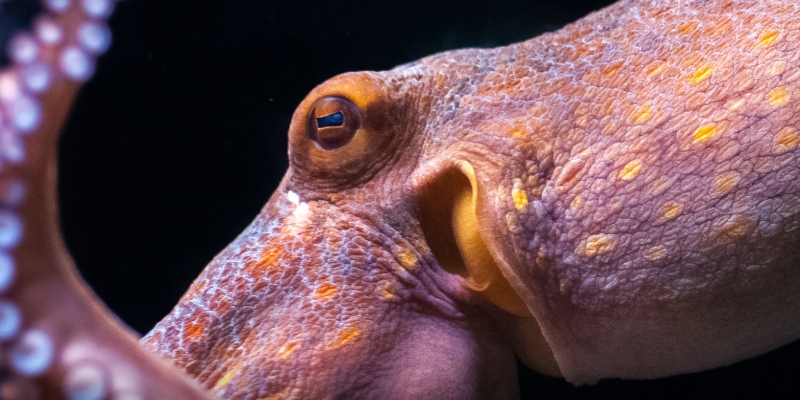
One major difference is the way the octopus eye focuses. It does so by moving its lens. This is almost identical to the way that you would focus a telescope or camera. Vertebrates, such as us, focus by modifying the shape of our lens as needed.
By relying on lens movement as opposed to shape-shifting, octopuses likely suffer from lesser instances of vision problems. On their driver’s licenses, you would rarely find the “needs to use corrective lenses” box check-marked.
All joking aside, having the ability to have sharp vision and also ensuring that it remains sharp throughout its natural lifespan is invaluable in the dog-eat-dog, or should we say, shark-eat-octopus world of the sea.
A moveable lens allows for an octopus to focus much quicker on an object, even if it is moving away from or approaching its position. An octopus’ vision focus has a natural “target-lock” capability.
The Octopus Eye Develops From an Invagination
Unlike vertebrates whose eyes develop as outgrowths of the brain, octopus eyes start as invaginations while they are embryos in their eggs. Before you start applying naughty overtones to the word “invagination,” be aware that it is a scientific term used in developmental biology. It refers to an inward fold in an outer layer of cells that develops early in the development of an embryo. This fold then grows into a unique feature of the creature. In this case, the eyes.
No Blindspot

One of the major benefits of the eyes developing from the “outside in,” is how this allows the retina to connect to the optic nerve without the latter having to pass through the photoreceptive layer at the back of the eye. The retinal axons, the “cables and plugs” that connect to the optic nerve to transmit information from the photoreceptive cells, travel over and behind the retina.
An easy way to visualize this is to imagine the cable that connects your security camera leading to your DVR or monitor. Instead of drilling a hole through your wall to pass the cable through, the cable reaches around the wall to make its connection. No need for a hole in the wall.
We and all vertebrates have a blind spot smack dab in the middle of our field of vision precisely because we do have a “hole drilled in our wall.” Our optic nerve and retina connect by going through the back of the eye. This creates a small area where we don’t have photoreceptive cells and therefore, a blind spot.
An octopus has a full range of vision without that blindspot. That is perfect when monitoring for potential predators or when scanning for prey.
No Cornea
Due to the octopus’ moveable lens used for focusing and the invagination method of embryonic eye development, octopus eyes do not have corneas.
Are Octopuses Colorblind?

There was a time when the prevalent opinion of marine biologists was that octopuses and all cephalopods, in general, were colorblind.
This was not out of ignorance, rather it was due to a reliance on a partial analysis of how octopus vision works instead of seeing the big picture.
Octopuses possess only one style of photoreceptor in their eyes. We humans possess three types of photoreceptors in our eyes. Each exclusively sensitive to red, blue or green light.
This disparity in variety of photoreceptors is what gave rise to the original theory that octopuses were colorblind. It was thought that their vision allowed them to only see the world in black-and-white or in shades of blue. Why blue? Because the individual type of photoreceptor of the octopus is sensitive to blue light.
Signs That Octopuses Can See Color

More recent studies indicate that octopuses may very well be able to see in color.
This would explain why octopuses exhibit color detection abilities both in the wild and in captivity. It also explains why their skin color-changing capability is sometimes used to warn other octopuses who are getting too close or during mating to attract a mate.
After all, while the ability to change skin color solely to hide from predators can be rationalized as an adaptation that developed independently of vision, using color to scare off or attract your own kind would not make sense if you could not see color.
A Different Way to See Color
The way we and other vertebrates see color involves different photoreceptors detecting different color wavelengths and then uniting them in the optic nerve and the brain to create a single multi-colored image. Much like a color projector does.
It is now suspected that octopus vision evolved to see in color using an entirely different method. The theory goes that octopuses use their differently shaped pupils to force light to enter their eye from different directions at once. Our pupils are round and are designed to allow light to enter from only one direction.
By having pupils which are U-shaped, S-shaped, and even M-shaped, the light entering the octopus eye is separated into the base component wavelengths of red, blue and green light. There is no need to have three different types of photoreceptors if that is the case.
By using micro-movements of the retina in conjunction with the lens movement involved with focusing, the octopus can then process the different light wavelengths and combine them in the optic nerve and brain to create a colorized image. This is a totally different way of processing color but computer models indicate that it would work.
A Dual Vision Style?
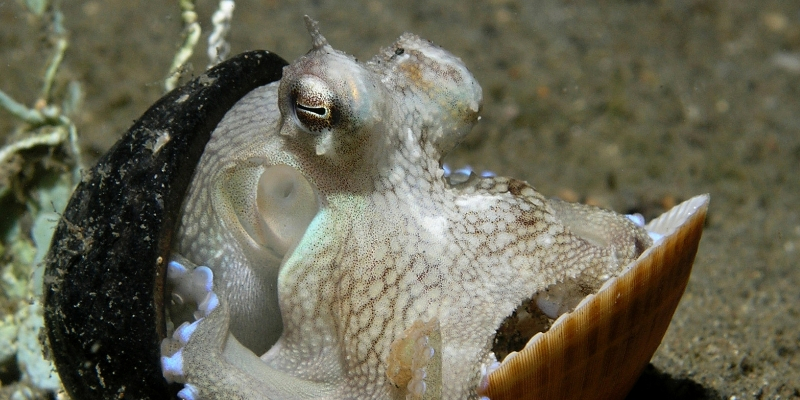
It is further theorized that octopuses may be able to switch from a colorized style of processing vision to one which is devoid of color.
Why would an octopus do that?
Since the octopus’ eyes possess the moveable lens structure that allows for sharpened and targeted focus, it would be wasted if they were constantly processing color by allowing their pupils to allow light in from all directions at all times. This would result in having constantly blurry vision. The sharpened-focus apparatus would be wasted.
This is what has spawned the theory that octopuses can switch from a focused style of vision with a narrow range of coverage that is colorblind to a wider panoramic style of vision that is fully colorized. The trade-off being that while in the colorized and wide-lens mode the picture would be somewhat blurry.
The blurriness problem would be less intense under lowlight conditions. Since most octopus species prefer moving about during nighttime hours, this lends further credence to the duality of vision theory.
A simplified analogy for this is how people use bifocals. The lower part of the lens helps them read up close and the upper portion of the lens helps them see at a distance. While this analogy does not apply to the mechanics of the different styles of octopus vision it can be applied to the dual purpose of two different vision styles by one set of eyes.
Do the Arms of an Octopus Help Them See?

It is important to note that nearly two-thirds of an octopus’ neurons are spread out through their arms. This is what allows them to “taste” with their arms. It has also been postulated that through the chromatophores, the specialized cells which allow an octopus to change skin color, the light that they reflect and use to match the color of their surroundings, is also processed by the neurons in the arm and transmitted to the brain of the octopus to combine with information from its eyes to paint a more exacting picture of the color around it.
Hey, if they can taste with their arms, why not detect colors with them as well?
Octopus Vision Is as Complex as the Creatures Themselves
Octopus vision is a topic as fascinating as the creatures themselves. The more is studied about the eye structure and neurology of the octopus, the more amazing the discoveries become.
Whether their amazing vision is a result of having a powerful brain neurology or if that very brain neurology is a result of having such a versatile and effective form of vision, the result is the same. In the octopus, we have an animal that is able to connect with its world with amazing ingenuity.










